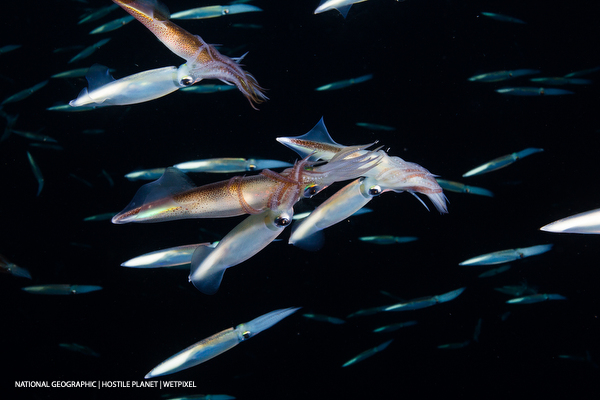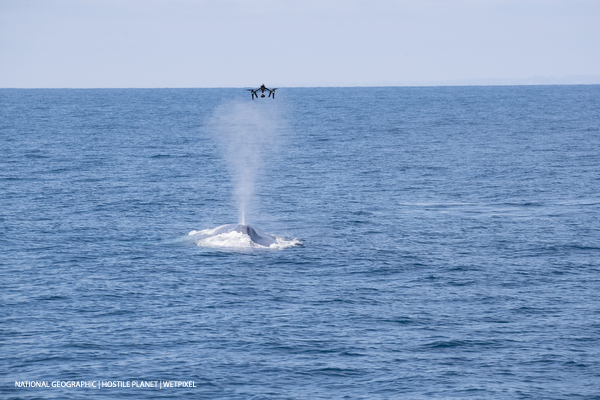Hostile Planet Filmmakers Interview - Part 2

Wetpixel: Technology has played a role in this production. What format were you filming in? I assume that a variety of cameras were used, but was there one format that was preferred?
Sophie: The main cameras used across the series were REDs, with other specialist cameras and drones used for particular tasks.
Dan: We were using the RED Helium in a GATES housing as our primary camera and had a Sony A7S MK2 in Nauticam housing, for when there was not enough light for the RED. Nowadays, we’d probably go with a RED Gemini (if it met the delivery specs for the production, being a lower res camera) - with its dual native ISO system we’d get a slightly extended shooting window, but we’d still also have the Sony, for when it gets very dark - preferably it would be an A7S MK3 - if it EVER materializes!
Roger: I used my DSMC2 Red Helium in a Gates Deep Weapon housing. It’s the natural history workhorse currently. We shot at high resolution, up to 8K, which gives a beautiful image when resolved down to UHD. It’s really crazy that we are resolving down to 4K, which only recently was a massive step up from shooting in HD! Shooting Red RAW R3D files means that editors and colorists can work in post-production in a non-destructive way. The camera also has a pre-record function, allowing the operator to track the action and only use up valuable data on the card when the little bits of magic happen.
Wetpixel: Did you use any special “one-of-a-kind” gear?
Sophie: We created a new remote focus, iris and zoom GH5 carbon fiber pole cam, which the Polar team lost off an ice shelf before we even got to use it! We also worked closely with MBARI (Monterey Bay Aquarium Research Institute) to obtain footage from the deep sea, filmed using their remotely operated vehicles. I also like to say that we more used one-of-a-kind camera operators. We really were working with some of the best in the world, with the ability to read animals and get in the best place for the most beautiful and immersive shots. I’m constantly in awe of them.
Wetpixel: What is your camera of choice?
Dan: The go-to camera for most shoots is the RED Helium, the versatile form factor of the camera means it suits a variety of camera platforms - it can be used in underwater housings, on gimbals, or in systems such as the GSS/Shotover, as well as in a traditional long-lens set up. The most recent DSMC2 brains are much more reliable than the older models, which is obviously critically important for remote shoots. All of this has very much made it the go-to camera for wildlife shoots, over any other system.
Wetpixel:Did rebreathers play a big part in the filming? How do you see new diving technology affecting the ability to capture new and different shots or behaviors?
Dan: Whenever possible I always use rebreathers rather than open circuit scuba. For me, deciding what gear to use when planning a shoot is all about reducing limiting factors, and extending working time. Limiting factors can take on many forms - camera batteries and media are seldom an issue these days, so the next limiting factors become things like available light, body temperature management, and dive time. Rebreathers just help to eliminate another factor. The reduced noise and lack of bubbles also definitely makes a difference when working around cetaceans. They are by no means an invisibility cloak, but to me there is no arguing with how much less they disturb the animals.
Roger: Rebreathers are amazing, and I probably use them on 80% of my shoots but they are not a Panacea. They have become much safer and more reliable and are now a vital part of our tool kit but for me it’s important to choose the right tool for the job. When assessing a job I look at a number of factors before deciding to go with rebreather, SCUBA or freediving. Sometimes it’s a combination of two or more of those but in this case, because I was following a rapidly moving subject which was up and down in the water column, I went with good old SCUBA. It meant I could deploy very quickly and I had a low profile so I expended less energy following the turtles.
Sophie: I’ve actually recently done my rebreather qualification as I got sick of being stuck supervising on the boat! We do use them on the majority of shoots now, but as Roger says, SCUBA can still be a useful tool. Rebreathers were vital for filming the squid mating aggregations in California – the events were happening at 35-40m depth and thus SCUBA simply would not have given enough bottom time.

Wetpixel: How important is drone filming to wildlife documentaries?
Dan: Drones have been a massive game changer in wildlife documentaries - obviously helicopters equipped with gyrostabilized cameras have been used in in wildlife documentaries for decades, but these can be disruptive to behavior, and are expensive - meaning you often have reduced time on location with them. You can have drones on your whole shoot inexpensively, and the cameras shoot fantastic quality. It’s difficult to imagine going back to shooting sequences without them now. In underwater filming especially, they add a whole extra angle onto a sequence, helping the viewer get a much greater understanding of the behavior and the story you’re telling. I’m excited to see where and how this technology will progress over the next few years.
Sophie: The drone of choice for the series was the DJI Inspire 2 with the X5S camera, which is capable of capturing 5.2K 30fps CinemaDNG video. What is exciting about this set up, as opposed to the earlier DJI drones, is the longer lens options and dual ops control. This enables you to get close up alongside animals with nice moves, rather than just a static plan view. So you get the cinematic shot without the payload and limited battery life of a drone carrying a larger camera. Plus these smaller drones can be landed on boats (with catch rails of course).
Wetpixel: Filmmakers, particularly with productions like this, have the ability to highlight environmental issues. Does Hostile Planet have a call to action?
Sophie: There is a really art to balancing conservation and escapism when it comes to high end natural history filming and I feel like Hostile Planet has been a series that has allowed us to hit the right mark. Climate change has seen the oceans steadily warm over the past 75 years, which is playing havoc with the marine world. And something horrible like 90% of fish stocks are overfished causing ecosystems to collapse and other issues, such as jellyfish blooms. All these issues are covered in the film, but we worked incredibly hard to incorporate them into the drama and visual beauty, so as not to break the spell.
Dan: This is a difficult balance to strike, as obviously these programs need to entertain as well as inform. For the Orca sequence, it was great that National Geographic Channel were happy with us tackling the fishing angle in the sequence - as well as providing some different imagery, it told an important story.
Wetpixel: How do you see the state of the world’s oceans? What can underwater image makers do to help?
Sophie: Human actions have without a doubt negatively impacted the oceans. But there is also a lot to be said for beautiful escapist wildlife film-making in terms of inspiring people to care about the natural world, and we all know that doom and gloom makes people switch off. However, I do feel that we have a moral obligation as filmmakers to find a way to tell the truth.
Roger: Living in Malaysia in SE Asia I see the effects of plastic pollution on a daily basis. My local beaches need to be cleaned daily as flip-flops, detergent bottles, plastic drinking bottles and all manner of trash are deposited on every incoming tide. I’ve also seen, anecdotally, a gradual degradation of many reefs that I’ve dived regularly over the past two decades. There is no doubt in my mind that our oceans and they habitats are under huge pressure on many fronts. I think as underwater image makers we do have a responsibility to get those pictures into the homes of people who don’t have the opportunity to visit the ocean regularly. I think it’s fantastic that big blue-chip programs like Hostile planet, that have traditionally focused on the beauty of the natural world, are now increasingly showing viewers the threats that our seas are facing.
Dan: To a large extent, we are somewhat at the mercies of the commissioners we are shooting for - whats great is that in the last couple years, the trend of commissioners avoiding conservation issues in documentaries is changing - and we’re being allowed to highlight conservation threats rather than glossing over them.
Wetpixel: Did you see any specific examples of how human actions have affected the behaviors you witnessed?
Sophie: As well as highlighting negative events, we thought it was important to also show the stories when human action had a positive impact – in recent years the blue whales, olive ridley turtles and herring we filmed have all rebounded from the brink after better protection and fishery regulation. That message of hope and resilience says (to quote Jurassic Park) that “Life finds a way” and that there is still time to make a difference. I saw more than 100 orca in one place and that wouldn’t have happened without fish stock recovery! That fishery is now MSC approved and is a prime example of why we should only eat fish from sustainable sources.
Wetpixel: Where is your favorite dive site?
Dan: The kelp forests surrounding the peninsular off of Cape Town - my adopted home, are my favourite place to be in the water. Despite being close to a major city, it’s such a wilderness still, with a stunning color palette. Plus, you never quite know what’s around the next kelp frond — keeps you on your toes!
Roger: That’s a hard question because as a cinematographer I’m very focused on the target species that we are filming so I don’t get to just enjoy a dive very often. My first ever filming dives were at Sipadan in Sabah, Malaysia. I’ve probably done over 3000 dives there over the years and I’m still really fond of it. It just has such an overwhelming amount of marine life in a concentrated area, the usual suspects like the friendly green turtles and huge school of jacks are always there but there’s always the potential for something special to emerge from the depths.
Sophie: I’ve been doing a lot of training in Egypt in the Northern Red Sea. Despite a noticeable absence of large fish, when you head further offshore the hard-coral cover is sensational. Recent studies suggest it may even be reasonably resistant to bleaching and provide a refuge for coral in the future – I’ve been known to cry the odd happy tear into my mask when I drop in.
Wetpixel: Thank you and all the very best!
As a reminder, Hostile Planet is currently airing internationally on National Geographic Channel. Please check out natgeo.com for more info or to watch and follow @natgeochannel on Instagram.
Part one of this interview series is here.